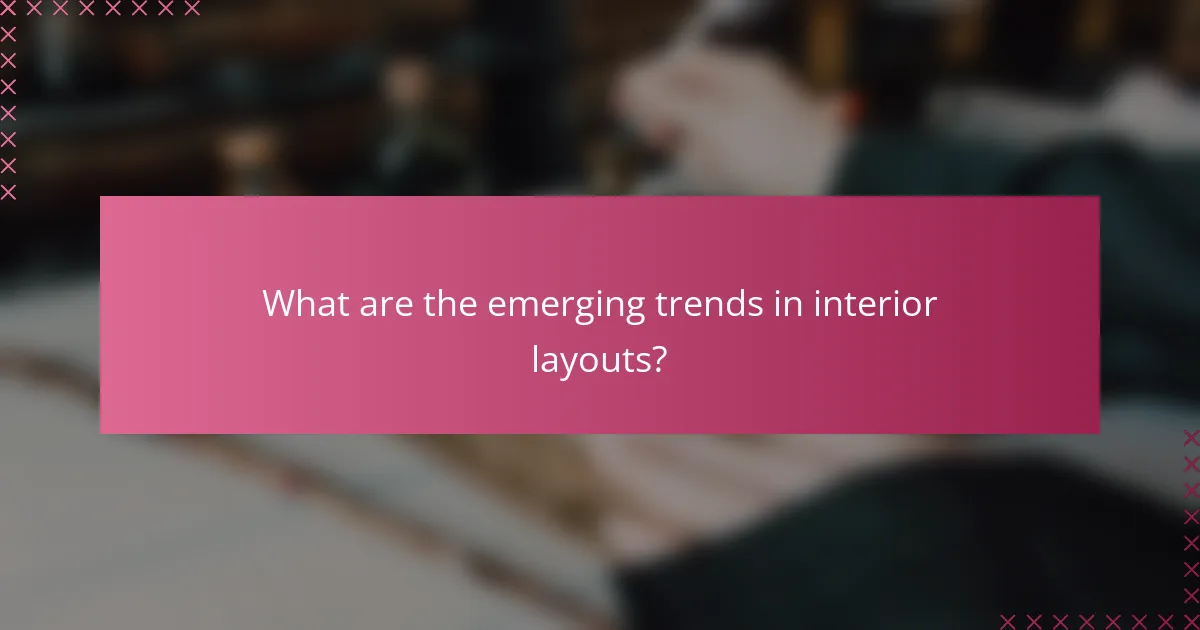Effective interior layouts are crucial for e-commerce spaces, as they enhance customer experience and streamline operations. By prioritizing quality materials and thoughtful design, businesses can create environments that are not only visually appealing but also functional. Additionally, readability plays a vital role in ensuring that occupants can easily navigate and engage with the space, influenced by factors such as signage, color schemes, and furniture arrangement.

What are the best interior layouts for e-commerce spaces?
The best interior layouts for e-commerce spaces focus on maximizing efficiency, enhancing customer experience, and facilitating smooth operations. Key layouts include open floor plans, grid layouts, flexible workspaces, showroom designs, and zone-based arrangements, each offering unique advantages tailored to specific business needs.
Open floor plan advantages
An open floor plan fosters collaboration and communication among staff, making it ideal for e-commerce businesses that rely on teamwork. This layout eliminates physical barriers, allowing for easy movement and interaction, which can enhance productivity.
However, noise and distractions can be drawbacks. To mitigate these, consider incorporating designated quiet zones or sound-absorbing materials. This balance can help maintain a dynamic yet focused work environment.
Grid layout efficiency
A grid layout is structured and organized, making it easy for customers to navigate through products. This layout is particularly effective in retail environments where product visibility is crucial, as it allows for clear pathways and logical product placement.
When implementing a grid layout, ensure that aisles are wide enough to accommodate foot traffic while allowing for displays that catch the eye. This can enhance the shopping experience and potentially increase sales.
Flexible workspace designs
Flexible workspace designs adapt to changing needs, making them suitable for e-commerce businesses that may scale operations or shift focus. This layout often includes movable furniture and modular spaces that can be reconfigured as needed.
Consider incorporating multi-functional areas that can serve various purposes, such as meeting rooms that double as storage spaces. This versatility can optimize space usage and reduce overhead costs.
Showroom layout benefits
A showroom layout is designed to showcase products effectively, allowing customers to experience items in a real-world context. This layout is beneficial for e-commerce businesses that offer high-value or complex products that require demonstration.
To maximize impact, arrange products in lifestyle settings that reflect how they would be used. This approach can enhance customer engagement and lead to higher conversion rates.
Zone-based layouts
Zone-based layouts divide the space into distinct areas for specific functions, such as inventory storage, customer service, and product displays. This organization helps streamline operations and improve customer flow.
When designing a zone-based layout, consider the proximity of related zones to minimize movement and enhance efficiency. For example, placing the checkout area near the exit can facilitate a smoother customer experience.

How does quality impact interior layouts?
Quality significantly influences interior layouts by determining the durability, aesthetics, and overall functionality of a space. High-quality materials and design choices enhance user experience and can lead to increased satisfaction and value.
Material selection for durability
Choosing the right materials is crucial for ensuring the longevity of an interior layout. Durable materials such as hardwood, high-grade metals, and quality textiles withstand wear and tear, reducing the need for frequent replacements. For example, opting for solid wood furniture instead of particle board can extend the lifespan of furnishings significantly.
Consider the environment where materials will be used. For high-traffic areas, select options that are resistant to scratches and stains, such as laminate or vinyl flooring. Additionally, check for certifications like GREENGUARD, which indicates low emissions and safer indoor air quality.
Design quality and customer perception
The quality of design directly affects how customers perceive a space. Well-executed layouts that prioritize functionality and aesthetics can create a positive impression, encouraging longer visits and repeat business. For instance, a thoughtfully designed retail space can enhance product visibility and accessibility, leading to increased sales.
Investing in professional design services can yield significant returns. A well-designed interior can elevate brand perception, making it essential for businesses to consider the impact of layout quality on customer experience and satisfaction.
Impact of lighting on layout quality
Lighting plays a vital role in enhancing the quality of an interior layout. Proper lighting can highlight architectural features, create ambiance, and improve functionality. Natural light, for example, can make a space feel larger and more inviting, while strategically placed artificial lighting can enhance specific areas.
When planning lighting, consider layering different types such as ambient, task, and accent lighting. This approach not only improves visibility but also adds depth and character to the layout. Avoid harsh or overly dim lighting, as both can detract from the overall quality and comfort of the space.

What are the readability factors in interior layouts?
Readability in interior layouts is influenced by several key factors that enhance how easily occupants can navigate and understand a space. These factors include signage clarity, color schemes, and furniture arrangement, all of which contribute to a functional and aesthetically pleasing environment.
Signage clarity and visibility
Clear and visible signage is crucial for guiding individuals through a space. Signs should be placed at eye level and use legible fonts, with a minimum height of 15 cm for text to ensure readability from a distance. High-contrast colors between text and background can further enhance visibility.
Consider using universally recognized symbols alongside text to aid understanding. For example, a restroom sign with both male and female icons can help convey information quickly to diverse audiences.
Color schemes and readability
Color schemes significantly affect readability by influencing mood and comprehension. Use contrasting colors to make text stand out against backgrounds; for instance, dark text on a light background is generally easier to read. Aim for a palette that is not overly bright or distracting, as this can lead to visual fatigue.
When selecting colors, consider the psychological impact they may have. Soft blues and greens can create a calming effect, while vibrant reds and yellows may energize a space. Always test color combinations in different lighting conditions to ensure they remain effective.
Furniture arrangement for flow
Furniture arrangement plays a vital role in the flow of a space, impacting how easily individuals can move and interact. Ensure pathways are clear and wide enough, ideally around 90 cm, to accommodate foot traffic without obstruction. Group furniture to encourage conversation while maintaining accessibility.
Consider the purpose of each area when arranging furniture. For example, in a waiting area, use comfortable seating that allows for easy movement, while in a conference room, arrange tables to facilitate collaboration. Regularly reassess the layout to adapt to changing needs and preferences.

How can formatting enhance interior layouts?
Formatting significantly enhances interior layouts by improving clarity and usability. Well-structured layouts allow for easier navigation and comprehension, making it simpler for users to engage with content effectively.
Digital tools for layout formatting
Various digital tools can streamline the layout formatting process, providing templates and design elements that enhance visual appeal. Software like Adobe InDesign, Sketch, and Canva offer user-friendly interfaces for creating professional layouts.
When selecting a tool, consider factors such as ease of use, compatibility with other software, and the specific features you need, such as grid systems or typography options. Many tools also offer collaborative features, which can be beneficial for team projects.
Best practices for layout documentation
Effective layout documentation ensures that all team members understand the design intent and can replicate it consistently. Start by creating a style guide that outlines font choices, color schemes, and spacing rules.
Additionally, maintain clear annotations within your layouts to explain design decisions. This practice not only aids current team members but also serves as a reference for future projects, ensuring continuity and coherence.
Importance of layout consistency
Consistency in layout is crucial for creating a cohesive user experience. Uniformity in design elements, such as headers, footers, and navigation menus, helps users navigate content without confusion.
To achieve consistency, establish a set of design standards and stick to them across all pages or sections. Regularly review layouts to ensure adherence to these standards, which can significantly enhance the overall quality and readability of your content.

What criteria should be used for selecting interior layouts?
When selecting interior layouts, key criteria include space utilization, customer journey mapping, and accessibility considerations. These factors ensure that the layout is functional, enhances user experience, and complies with relevant standards.
Space utilization metrics
Space utilization metrics assess how effectively a layout uses available space. Key metrics include occupancy rates, which should ideally be above 70%, and the ratio of usable to total space. A well-utilized layout maximizes functionality while minimizing wasted areas.
Consider using tools like floor plan software to visualize space allocation. Regularly review and adjust layouts based on actual usage patterns to improve efficiency and comfort.
Customer journey mapping
Customer journey mapping involves analyzing how users interact with a space from entry to exit. This process helps identify pain points and opportunities for improvement in the layout. For example, ensuring clear pathways and strategically placing signage can enhance navigation and satisfaction.
Incorporate feedback from actual users to refine the layout. Observing customer behavior can reveal insights that data alone might miss, leading to a more intuitive design.
Accessibility considerations
Accessibility considerations ensure that all individuals, regardless of ability, can navigate the space comfortably. This includes adhering to standards such as the Americans with Disabilities Act (ADA) in the U.S. or similar regulations in other countries, which mandate features like ramps, wide doorways, and accessible restrooms.
Evaluate the layout for potential barriers and incorporate features like tactile signage and adjustable furniture. Regular accessibility audits can help maintain compliance and improve the overall experience for everyone.

What are the emerging trends in interior layouts?
Emerging trends in interior layouts focus on maximizing functionality, enhancing comfort, and promoting sustainability. Key developments include open floor plans, multifunctional spaces, and the integration of technology to create adaptable environments.
Open Floor Plans
Open floor plans continue to gain popularity as they create a sense of spaciousness and encourage social interaction. These layouts remove barriers between key living areas, such as the kitchen, dining, and living rooms, allowing for seamless movement and communication.
When designing an open floor plan, consider the flow of traffic and how different zones will be defined. Use furniture placement, area rugs, or lighting to create distinct areas without physical walls. This approach can enhance both aesthetics and functionality.
Multifunctional Spaces
Multifunctional spaces are becoming essential, especially in urban environments where square footage is limited. Rooms that serve multiple purposes, such as a guest bedroom that doubles as a home office, are increasingly sought after.
To effectively design multifunctional spaces, prioritize flexibility. Use foldable furniture, such as Murphy beds or extendable tables, to maximize usability. This trend not only conserves space but also caters to diverse lifestyles and needs.
Integration of Technology
The integration of technology into interior layouts is transforming how spaces are utilized. Smart home systems allow for automated control of lighting, heating, and security, enhancing convenience and energy efficiency.
When incorporating technology, ensure that it complements the overall design rather than detracting from it. Consider built-in speakers, smart thermostats, and automated window treatments that blend seamlessly with the interior aesthetic, providing both functionality and style.
